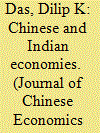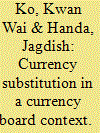| Srl | Item |
| 1 |
ID:
071219


|
|
|
|
|
| Publication |
2006.
|
| Summary/Abstract |
Both China and India were noted for their prowess and prosperity in the remote past, but in the recent past they went into a precipitous decline and became marginal economies, known for large impoverished masses and economic stagnation. Early in the 21st century, China and India are once again being seen as two emerging economic powers of the global economy. The closing decades of the 20th century were remarkable for both the economies. China in particular turned in a stellar economic performance. In the beginning of the 21st century, it was even being seen as the economic super power of the future. It has emerged as a low-cost manufacturing juggernaut invading global markets in a sizeable array of products, with a high and rapidly rising level merchandise exports and imports. In comparison, India's post-1991 growth performance has shown improvement. Although its success in the services sector exports is noteworthy, its economic performance did not match that of China. The economic weight of China and its integration into the global economy is going to continue to increase, and India could follow suit. This article compares and contrasts the two emerging-market economies of Asia, their soaring global significance and global integration and draws policy related lessons from it.
|
|
|
|
|
|
|
|
|
|
|
|
|
|
|
|
| 2 |
ID:
071217


|
|
|
|
|
| Publication |
2006.
|
| Summary/Abstract |
Hong Kong is an open economy that uses foreign currencies extensively in domestic payments. This paper focuses on substitution between the domestic and foreign currencies in their role as media of payments in such an economy. It uses quarterly data to estimate currency substitution (CS) for Hong Kong during 1984:I to 2001:III when it had a fixed exchange rate under a currency board system. Two models, a money demand function and a dynamic adjustment model, are estimated using the Johansen cointegration and error-correction technique. The estimates for both these models indicate significant CS in the media of payments. Our estimates also show a significant ratchet effect in CS.
|
|
|
|
|
|
|
|
|
|
|
|
|
|
|
|
| 3 |
ID:
071215


|
|
|
|
|
| Publication |
2006.
|
| Summary/Abstract |
This paper examines the linkage between aggregate real output, capital, labour, education, and productivity within a growth accounting framework for 27 Chinese provinces between 1990 and 2000. The results suggest that human capital has had a significant role in facilitating economic growth of all of the provinces throughout the 1990s. Regional disparities in factor accumulation are also considered. The results suggest that uneven distribution of resources between the coastal and inland provinces increased the regional gap in economic growth throughout the 1990s.
|
|
|
|
|
|
|
|
|
|
|
|
|
|
|
|
| 4 |
ID:
071213


|
|
|
|
|
| Publication |
2006.
|
| Summary/Abstract |
China has a built-in inflationary tendency because of the partially-reformed nature of its economic system. Specifically, the post-1978 marketization of the economy has interacted with the continued state ownership to create an inflationary 'liquidity tango' between the state-owned enterprises (SOEs) and the state-owned banks. Whenever the hard budget constraint is imposed on the SOEs, China's dysfunctional financial system would impart a deflationary bias to the economy and render China a capital exporting country by constraining the growth of aggregate demand to be less than the growth of aggregate supply. The use of price mechanisms as the only instruments for all economic problems is not appropriate for China's transitional economy, e.g. trade surpluses are better handled by the establishment of an efficient financial intermediation mechanism than by appreciation of the Yuan.
|
|
|
|
|
|
|
|
|
|
|
|
|
|
|
|